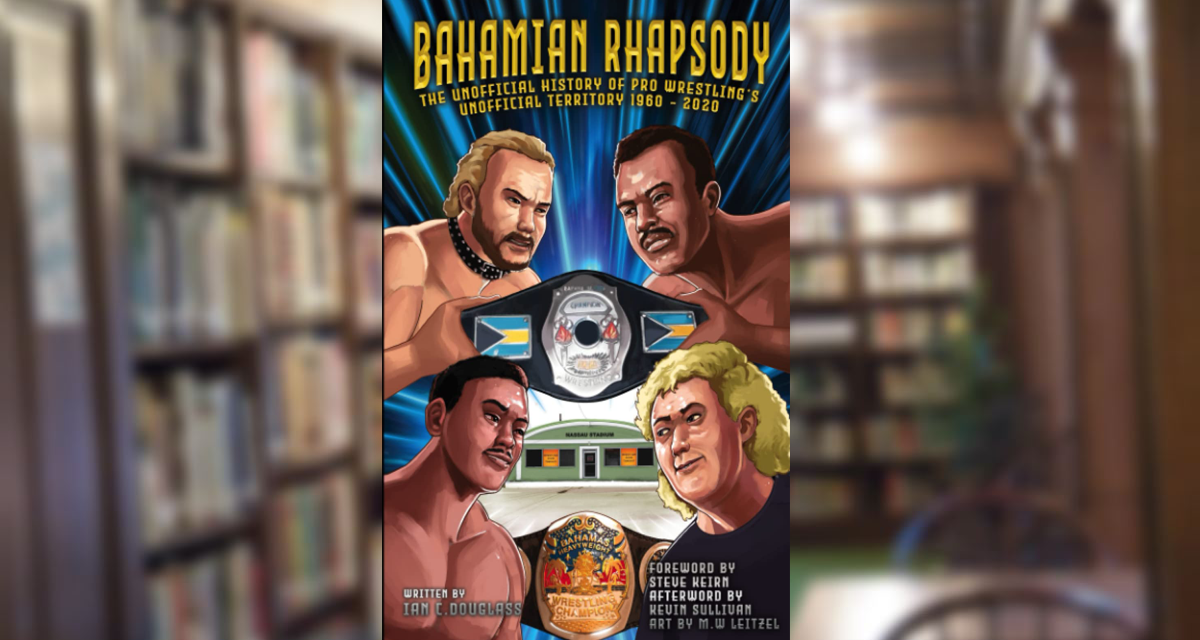Confession time: this reader ventured into author/journalist Ian Douglass’ latest book, Bahamian Rhapsody: The Unofficial History of Pro Wrestling’s Unofficial Territory 1960 – 2020, with an icy chip on my shoulder. You see, when I started reading the book, winter arrived here in Winnipeg, Manitoba — aka as “Winterpeg” — so reading a book focused on the balmy Bahamas brought on some feelings of bitterness.
Despite never having been to the Bahamas myself, nor knowing anything about the pro wrestling scene that existed there, I have to admit that Douglass has given readers an articulate, diligently researched, and infectious guide/history book on the subject. I highly encourage any skeptical readers not to “write” this book off as one meant for a very niche audience and give it a chance. I say this because I had those same thoughts myself before I started reading it. Yes, I literally judged a book by its cover in this instance, which frankly is never a good idea. Alas, I do have to mention that the book does not come with airplane tickets to the Bahamas. Trust me I checked! Twice!
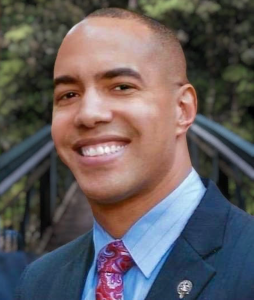
Ian Douglass. All story photos were contributed by Douglass.
The book was definitely a passion project for Douglass and as many great projects/stories do, it all started because of a live pro wrestling event.
“My mother is a native Bahamian, and the first wrestling event I ever attended live was in Nassau (on New Providence Island in the Bahamas) in 1989, Dusty Rhodes and Fred Ottman in the main event, and with folks like Steve Keirn, Al Perez, Tyree Pride, Mike Graham, Scott Hall, Scott Levy, and The Nasty Boys on the undercard,” shared Douglass in an email interview with SlamWrestling.net. “Ever since that time, I’d had questions about the history of wrestling in the Bahamas, and I assumed that if the information I compiled would be interesting to me, it would be of interest to at least a few other people as well.”
Douglass began acquiring the answers to his questions about Bahamian pro wrestling in early 2018 and spent the next four and a half years researching, writing, and conducting interviews for this book. Pro wrestling book fans will recall that Douglass’ previous work includes the autobiographies of Dylan “Hornswoggle” Postl, Dan Severn, B. Brian Blair, and Buggsy McGraw. Douglass also released a coloring/comic book on McGraw.
“I interacted with close to 50 people (including pro wrestlers like Blair, McGraw, Keirn (who also wrote the book’s Foreword), Kevin Sullivan (who wrote the book’s Afterword), Mike Rotunda, D-Von Dudley, Kurt Angle, Jim Cornette, and Diamond Dallas Page) whose statements and remembrances – both great and small – were included in this book,” explained Douglass. “In some cases, it was as simple as making requests for introductions through some of my well-connected friends, and in other cases I had to chase down leads, like contacting Bodine Johnson – the daughter of Bahamian wrestling legend Arnsel Johnson – and getting her help recording an interview with her father.”
Added Douglass, “I want to recognize and thank all of the people who contributed either statements or interviews for the book, and especially those who passed away before the book could be completed. Unfortunately, that list includes Rocky Johnson, Rusty Brooks, Butch Reed, Reggie Parks, and Howard Brody. The fact that people that I’d spoken with for this book project were literally dying during the process increased my urgency to finally get it completed and released.”
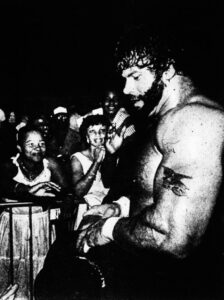
Billy Jack Haynes walks to the Nassau Stadium ring while adoring fans look on. Photo credit: Derek Smith/The Nassau Guardian.
As the book’s title foretold, Douglass covers the pro wrestling scene in the Bahamas from 1960 all the way up to 2020. Most of the pro wrestling shows in the Bahamas were under the banner of the Florida territory of the National Wrestling Alliance (NWA), Championship Wrestling from Florida (CWF). For those of us who aren’t geographically minded, Douglass points out in the book that “a plane trip to Nassau from most locations in Florida was still shorter in duration than a cramped car ride from Tampa to Jacksonville.”
Plenty of well-known pro wrestlers (even some Canadian ones!) ventured to the Bahamas including Ric Flair, Gene Kiniski, Angelo Mosca, Barry Windham, Luna Vachon, Sting, Steve Austin, Ricky Steamboat, Dwayne “The Rock” Johnson (who wrestled in the Bahamas only one time as the tag team partner of his father) and many, many more. World Championship Wrestling (WCW) even held two live shows in the Bahamas. The popularity of pro wrestling on the island even warranted the creation of the NWA Bahamas Heavyweight Championship belt and the Bahamian Island Tag Team titles. And here’s some trivia you can use to impress your friends: Douglass shared in the book that “the first organized wrestling bout in Bahamian history would be a women’s match pitting Ella Waldek against Bonnie Watson.”
Douglass relied on plenty of interviews to guide readers through the various eras of pro wrestling in the Bahamas. In addition, he also utilized the archives of both The Nassau Tribune and The Nassau Guardian newspapers. For the newspaper scouring, Douglass acquired the assistance of four University of Florida research assistants.
“I realized early in the process of working on the book that it would have taken me forever to complete the necessary research if I worked solely through the National Archives in the Bahamas,” confessed Douglass. “When you go there, you’re required to request a microfilm reel, search through it, find the article you’re looking for, write it down somewhere, bring it to an employee at the Archives, and request that they go look up the same article in a back room and print it out for you on a sheet of paper.”
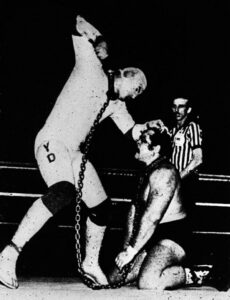
“Yellow Dog” Barry Windham punches away at Ron Bass while Bill Alfonso watches closely. Photo credit: Derek Smith/The Nassau Guardian.
One of this reader’s favorite parts of the book was reading about the passionate Bahamian pro wrestling fans. Whenever I take my husband to a live pro wrestling show he always remarks that the wrestling fans sometimes are more entertaining than the actual show. Well let’s just say the Bahamian fans take their wrestling extremely seriously. With the locals fully believing in kayfabe (believing pro wrestling story lines are real), Douglass shared countless examples of fans throwing all sorts of objects, from rocks to bottles and more, at the heel (bad guy) wrestlers; rushing the back stage area when the heel wrestlers were trying to make their exit; and the local police having to often step in to contain the rowdy audience. Lex Luger even had a fan throw a cup of urine into his face after a match.
In Chapter 13, which is entitled “Rocks, Bottles, and Conch Shells” and is a lively and wild read highlighting the antics of these local fans, Kevin Sullivan, who claims to be the final NWA Bahamas Heavyweight title holder, shared this memorable, yet shocking story: “There was a time when one of the Bahamians in the crowd had a cinder block and threw it at King Tonga, and hit him in the head. He had to walk it off like it didn’t hurt. Another time, Jake “The Snake” Roberts had heat with some of the guys in the dressing room, and they wanted to get back at him. The boys let a bunch of fans into the heel dressing room, and they wrapped a rug around Jake and beat him with sticks the same way you’d beat a rat.”
Along with delving into pro wrestling, Douglass also provides readers with plenty of local color resulting in essential Bahamian context and its impact on the island’s pro wrestling scene. In just one example, Douglass detailed that in 1961 the Bahamas Boxing and Wrestling Commission was created as a “clean up” response after a match between Buddy Austin and Sweet Daddy Siki. Austin ended up disqualified at the end of the match and when he was going to hit Siki with a steel chair, the fans revolted in response. Police had to be called in to deal with the mob and get Austin out safely. Douglass writes: “It became a near impossibility for wrestling organizations headquartered in the United States to operate in the Bahamas without oversight from Bahamians heavily involved in the national boxing scene.” This new involvement “ran the risk of exposing the true nature of wrestling and permanently spoiling the money-making potential of the Bahamas as a pro wrestling mecca.”
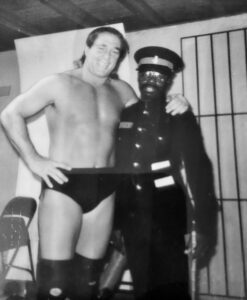
Steve Keirn with a member of the Royal Bahamas police.
Offered Douglass, “This book is intended to be a thorough account of wrestling in the Bahamas with substantial attention paid to the perspectives of the Bahamians as consumers of the wrestling content, and that involves looking at several of the geopolitical factors that were in play during the eras in question. Several of the accounts of wrestling in the Bahamas that have made the rounds online have been one-sided, falsely delivered as firsthand accounts by people who weren’t even there to view the incidents in question, and also exaggerated and embellished for the sake of entertaining a predominantly American audience without any consideration given to the circumstances of the fans who were watching the wrestling. Hopefully this book will take several of those stories, set them upon a framework of truth, and provide factual accounts about pro wrestling in a nation that more than one wrestler described as a ‘gold mine’ when it was operating at its peak.”
The book concludes by spotlighting Bahamian pro wrestler Omar Amir, whose determination to succeed in the squared circle and his most unique journey, one that included him joining the U.S. military in order to stay in the country, and eventually led to Amir being crowned the Ohio Valley Wrestling (OVW) Heavyweight Champion.
“Honestly, my favorite set of interviews was with Omar Amir, the Bahamian pro wrestler who is a multi-time heavyweight champion in Ohio Valley Wrestling,” revealed Douglass. “To get the firsthand account of the difficulties he endured and the sacrifices that were required for him to make it to the United States to train with The Dudley Boyz, to take a multi-year hiatus from training to secure his status as a U.S. citizen so that he could finish his training, and then to hear about his progression through the ranks of the indies, it just reinforced just how much effort is required for a citizen of a tiny island nation to purposefully pursue a dream as a pro wrestler in the U.S. Training to become a professional wrestler always requires sacrifices, but those sacrifices are more severe for trainees from countries with no pro wrestling infrastructure who wish to maximize their opportunities in the wrestling business.”
Other than being part of the journey for Chris Jericho’s Rock N Wrestling Rager at Sea cruise, the pro wrestling scene in the Bahamas has indeed gone from rockin’ to docking. When asked if there could ever be a serious resurgence of pro wrestling on the island, Douglass wasn’t optimistic.
“Unfortunately, the answer is ‘probably not,’ and that’s for a couple of reasons,” Douglass concluded. “Now that everyone knows professional wrestling is a dramatized representation of combat, it would be difficult to produce a crop of wrestlers within such a tiny island nation and have them organically develop enough of a fanbase to fill attractive venues on a consistent basis. On top of that, modern Bahamian wrestling fans have access to the full range of American television programs and are familiar with the popular wrestling programs on an international level. You can’t bring a group of unknown wrestlers to the Bahamas in this era and fill any sort of venue simply because the marquee says ‘wrestling’ on it. Bahamians aren’t that starved for entertainment. However, if WWE (World Wrestling Entertainment) or AEW (All Elite Wrestling) opted to give some of their wrestlers a working vacation while running an event at the Atlantis Hotel or Baha Mar, I think fans – both Bahamian and international – would materialize for it the same way they show up for the NCAA’s (National Collegiate Athletic Association) Battle 4 Atlantis and Baha Mar Hoops tournaments each year.”
RELATED LINKS
- Buy Bahamian Rhapsody: The Unofficial History of Pro Wrestling’s Unofficial Territory 1960 – 2020 on Amazon.com or Amazon.ca
- SlamWrestling Master Book List
- Ian Douglass: Website and Twitter
- Sep. 5, 2021: B. Brian Blair creates a buzz with his autobiography
- Mar. 25, 2021: ‘The Incredible Brute’ brutalizes babyfaces in his first comic/coloring book
- Sep. 9, 2019: Book, promotion, family keep ‘Hornswoggle’ Dylan Postl busier than ever
- Apr. 12, 2019: Buggsy McGraw’s journey from heel to comedic hero told in autobiography
